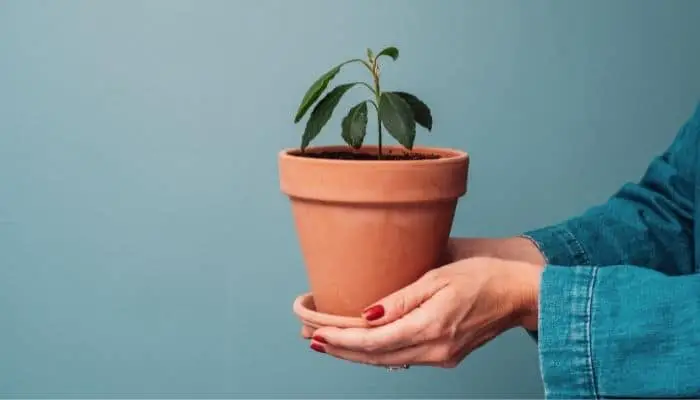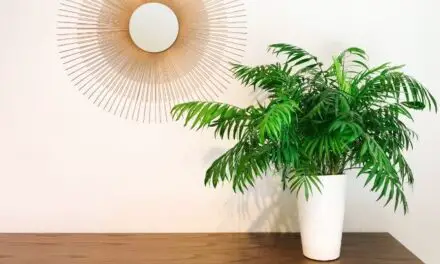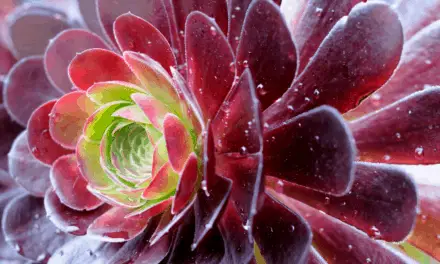With their long rich green leaves, avocado trees make really beautiful houseplants.
They are also pretty easy to look after, as long as you can offer them plenty of light and warmth.
But there are a couple of key elements of care when minding this plant and if you don’t get them right, it can quickly begin to look sad.
Table of Contents
Why Is My Avocado Plant Drooping?

Avocado plants most commonly droop when they have been overwatered, but they can also droop when they are kept in a pot that’s too small, underwatered, not giving enough light, or suffering from transplant shock.
Overwatering
Avocado plants don’t like a lot of moisture, and will generally wilt if they get too much water around their roots too often.
You’ll want to let the soil in the pot dry out pretty much all the way before you water again.
Excess water stops them from being able to get enough oxygen through their roots, so the plant is essentially suffocating.
You can easily check your avocado’s soil by pushing your finger into the pot.
If the soil feels wet, the chances are that the plant is getting too much water and you need to let it dry out.
You could test the soil with a moisture meter, pushing it all the way down into the bottom of the pot and only watering when it reads very dry.
In the summer, you may need to water your avocado plant about once every 7 to 10 days and even less in winter.
But it is always best to let the plant tell you when it needs water by checking the soil for dryness.
If you see yellowing of the leaves it’s usually a sign that you are overwatering and need to cut back.
Poor Drainage
If you don’t think you are watering your avocado too often, it may be that your pot doesn’t have sufficient drainage.
If Soil Is Too Wet, You May Need To Repot
It’s a good idea to address this and move your plant to a pot with plenty of drainage holes, or your plant is likely to suffer from root rot.
You should choose a pot with plenty of drainage holes, and then add a layer of gravel at the bottom of the pot so that the water can drain away from the roots.
You can also use a few small pebbles if you don’t have gravel.
If your avocado plant is very wet when you repot it, give the roots some time to dry out before placing them in the pot and topping it up with new soil.
Don’t reuse the old soil as it will still be wet and maybe harboring mold spores.
Water your avocado plant sparingly once it has been re-potted, and give it time to settle in.
This should help with the drainage problems in the future.
If the plant’s drainage is fine, simply reduce how often you water it and make sure the soil is getting a chance to dry out properly.
Related Article: Do Basil Plants Die After Flowering? (Explained)
Underwatering
You probably aren’t watering your avocado too little, but it is possible for drooping and limp leaves to indicate thirst.
Again, check your plant’s soil by pushing a finger into it and feeling the dampness to a depth of at least 2 inches.
If the soil feels quite dried out, your plant probably wants a drink.
Give it some water, and check that the drainage is sufficient by making sure this has dried out before too long – a couple of days and the soil should no longer feel very damp.
Avocados are native to tropical and sub-tropical regions and like to be watered heavily (watered until it runs out of your pot’s drainage holes).
When watered regularly with small amounts, it can cause build-ups of salt in the soil which can affect the health of your avocado.
When watering, give plenty of water until it is running out of the bottom of the pot.
And try not to use water straight from the tap.
Collect rainwater or use mineral water.
If you have to use tap water, leave it out in an open container for a day so that chemicals have a chance to evaporate from it.
Transplant Shock
An avocado plant that has recently been repotted may begin drooping if it suffers from transplant shock.
This is a sign that the plant has been stressed by the move, and the plant is putting its energy into adjusting to the new conditions.
The roots must reestablish themselves in the soil and the plant must adapt to the different soil and possibly different environment.
Transplant shock should resolve itself after a few days; the plant will settle into its new environment and return its focus to its leaves and photosynthesizing.
In the meantime, avoid shocking the plant in other ways (e.g. moving it around) and keep its stress low by not over-watering it.
Pests Or Lack Of Light
Another couple of potential reasons for droopy leaves on your avocado plant is pests and a lack of light.
These plants are popular targets of mites and mealybugs (both of which can cause limp leaves), and they can also suffer from sun damage if they get too much direct light.
Check a limp avocado plant for signs of pests on the leaves, and move it away from excessive sun exposure.
Avocados are native to Mexico where the sun beats down on them all day long.
And if you can’t offer them enough light they may begin to droop.
When keeping them indoors, the best spot for them is right in front of the sunniest window you’ve got.
Keep them back a little bit from the window just to make sure the sun doesn’t magnify when passing through the glass and burn them.
If you don’t live in an environment that can offer up the amount of sun that these plants thrive in, you may need to invest in a grow light.
The best artificial light for indoor avocado plants is full-spectrum lights.
These lights simulate direct sunlight and your avocado will love them.
Your Pot Is Too Small
Avocados don’t do well when root-bound and if their pot is too small they may begin to droop.
Their roots are also prone to growing in circular formations which may stunt the growth of your avocado plant when its container is too small.
If your pot is too small you’ll have to check the roots and repot your plant.
Any roots that are growing in a circle should be cut so that they have a chance to spread out and function as they should.
Roots that continue to grow in a circular formation don’t function properly and may eventually end up suffocating your plant.
How To Tell If Your Avocado Plant Is Rootbound
Take a good look at your avocado tree’s container to see if your plant is rootbound.
Give the pot a squeeze and see if the roots are pushing out against the sides of the pot.
Press against the pot to loosen the root ball.
If it’s overgrown and stuck, you may have to cut the pot off.
If the roots are compacted, tangled, and filling the entire pot, your avocado is rootbound and should be repotted.
As your avocado grows, you may have to change its pot multiple times.
When repotting, choose a pot 2 or 3 inches bigger than the old one and try to pick one that’s breathable and has good drainage.
Your avocado may droop even more as it directs energy into getting its roots re-established into the new soil.
But it should quickly bounce back once you don’t let it get too cold and provide it lots of bright indirect sunlight.
How To Prevent Your Avocado Plant From Drooping
To prevent your avocado from drooping, you’ll need to provide it a pot with good drainage, only water it when the soil has fully dried out, ensure that it’s receiving as much full sun as possible, keep it at a temperature of between 60 to 85 degrees F and repot it when it becomes root-bound.
How To Revive A Droopy Avocado Plant
To revive your drooping avocado, you will have to look closely at the care it is receiving.
The most common cause and the one to look at first is incorrect watering.
Test The Soil
Test the top 2 inches of soil with your finger and if it feels very moist your avocado may have been getting too much water.
Also be on the lookout for yellowing leaves, which is another strong indication of overwatering.
Inspect The Roots
Lift the plant out of its container and inspect the roots.
If any of them look mushy and black, it’s most likely root rot.
If only a few roots look like they are rotting, you can cut them away and replant your avocado in fresh soil with good drainage.
If the entire root structure is mushy and rotting then it’s probably too late.
If Underwatered
If your avocado plant is drooping and the soil is very dry, your plant needs a drink and there is probably nothing to worry about.
Underwatering is a lot safer than overwatering.
In fact, avocado plants will droop when thirsty and many people wait for their avocado to droop its leaves before giving it water.
If this is the case, you’ll just need to give it some water and it should perk up within a couple of hours.
If Not Receiving Enough Light
Avocados are some of the most light-loving plants you will find and if you deprive them of it, they may droop their leaves.
They need to be kept at a window that gets sun for most of the day.
If you’re living in a home that cannot provide that, you may have to get a grow light.
Outside of water and light issues, pests and pot size are the next most likely.
Too Rootbound
Avocados struggle when rootbound so if this is the case you’ll have to repot it to a container that’s 1 or 2 inches bigger.
Pests
Sap-sucking insects are also a worry for your avocado and may cause it to droop.
Besides drooping, If you notice any webbing or leaf discoloration you may have a pest infestation.
A good spray down with neem oil insecticide is usually a good solution to pest problems.
Conclusion
There are a few reasons that an avocado plant might have droopy leaves, but the most likely explanation is overwatering, so check the soil’s moisture levels first.
If you find the plant is too wet, consider repotting it to avoid the potential for rotting/mushy roots.
Increase the drainage, and water it less in future.




